How to Measure the ROI of SEO
Measuring SEO’s ROI puts the impact of SEO into perspective. Considering that high-quality campaigns average ~748% ROI, you can use that data to show company leaders how SEO has generated traffic, leads, and sales, which can lead to continued investment in this strategy.
Want to know how to calculate SEO ROI? Keep reading to break down the following topics:
- What is SEO ROI?
- Why measure SEO ROI?
- How to measure SEO ROI
- User purchase journey: An alternative to measuring ROI SEO
- Challenges to SEO ROI
- SEO ROI examples by industry
- FAQs about measuring ROI for SEO
For professional help improving your ROI, contact us online or call 888-601-5359 to learn more about our SEO plans!
What is SEO ROI?
SEO ROI is a calculation that measures the return on investment of search engine optimization. Companies can calculate SEO’s return on investment by looking at search engine rankings, organic website traffic, and goal completions, and then using the ROI SEO formula:
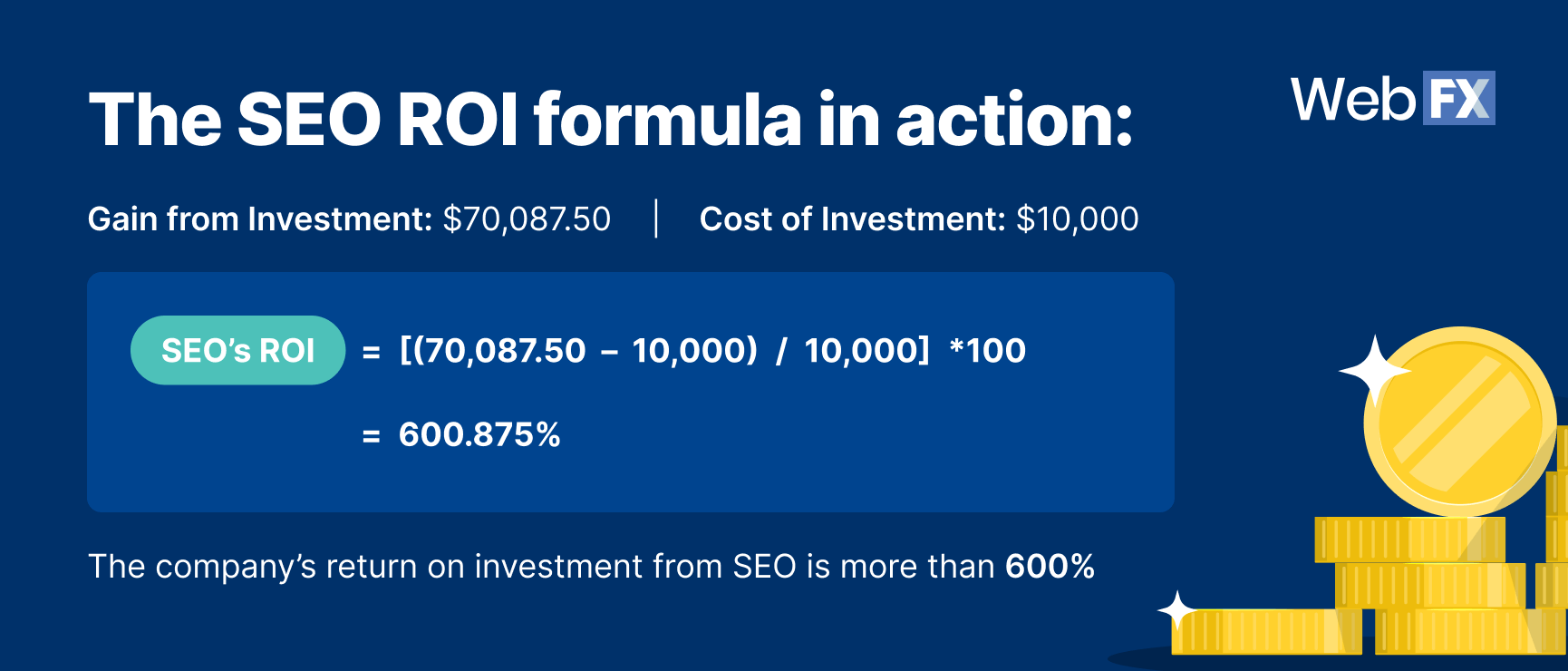
Why measure SEO ROI?
Understanding where your budget goes helps you save money on effective strategies.
Businesses who use data-driven strategies drive five to eight times as much ROI as businesses who don’t. If you want to see how SEO impacts your business, synthesizing your data to calculate SEO ROI is necessary.
The primary benefits of finding SEO return on investment include the following:
- Convincing company leaders: When trying to prove the importance of SEO to decision-makers, you need data. Finding the ROI of your SEO efforts can prove your success in dollar amounts to encourage them to keep investing.
- Making SEO decisions: You can use SEO ROI and performance data to determine what channels and pages bring in the most revenue for the company. As you learn where your revenue comes from, you can continue investing in the appropriate tactics.
- Measuring success: Since SEO is an ongoing process, it can take time to measure success. ROI will show your company’s wins and help you make the most of your budget over time.
- Combatting economic factors: Current economic factors, such as inflation and recession, may limit marketing budgets. Using ROI as a metric shows the value of your SEO strategy in times where impactful marketing spend is more essential.
With all these benefits, it’s clear that SEO ROI is crucial to your company’s standing.
How to measure SEO ROI
To calculate SEO ROI, you can follow these steps, or use our calculator below:
- Calculate your investment
- Set up conversion tracking
- Calculate your SEO ROI
1. Calculate your investment
To get started with SEO ROI, you must first calculate how much you are investing in SEO. From there, you can start measuring the income generated from your investments.
Your investments should include the following:
- In-house employees
- SEO agencies and freelancers
- Any SEO tools
- Content distribution and link-building payments
2. Set up conversion tracking
The next step in determining your ROI from SEO is setting up conversion tracking in Google Analytics (GA4). This step allows you to track all the conversions on your site that earn revenue. The setup you use depends on whether you make sales directly on your site or not.
Ecommerce stores can use ecommerce tracking to pull data from their online transactions and measure their exact online revenue. This tracking capability means the data for online returns is extremely accurate.
Lead-based businesses, like service providers, can set up conversion goals like lead form submissions and assign dollar values to those goals based on customer data.
Here’s how both types of businesses can set up conversion tracking on their sites:
Ecommerce events
The best way to track revenue from an ecommerce store is to set up ecommerce tracking events using Google’s instructions. This process will help you capture ecommerce data and send it straight to GA4 for analysis.
Once you start tracking ecommerce events, you can access an ecommerce report (Reports > Monetization > Ecommerce purchases) with all the information related to your online sales.
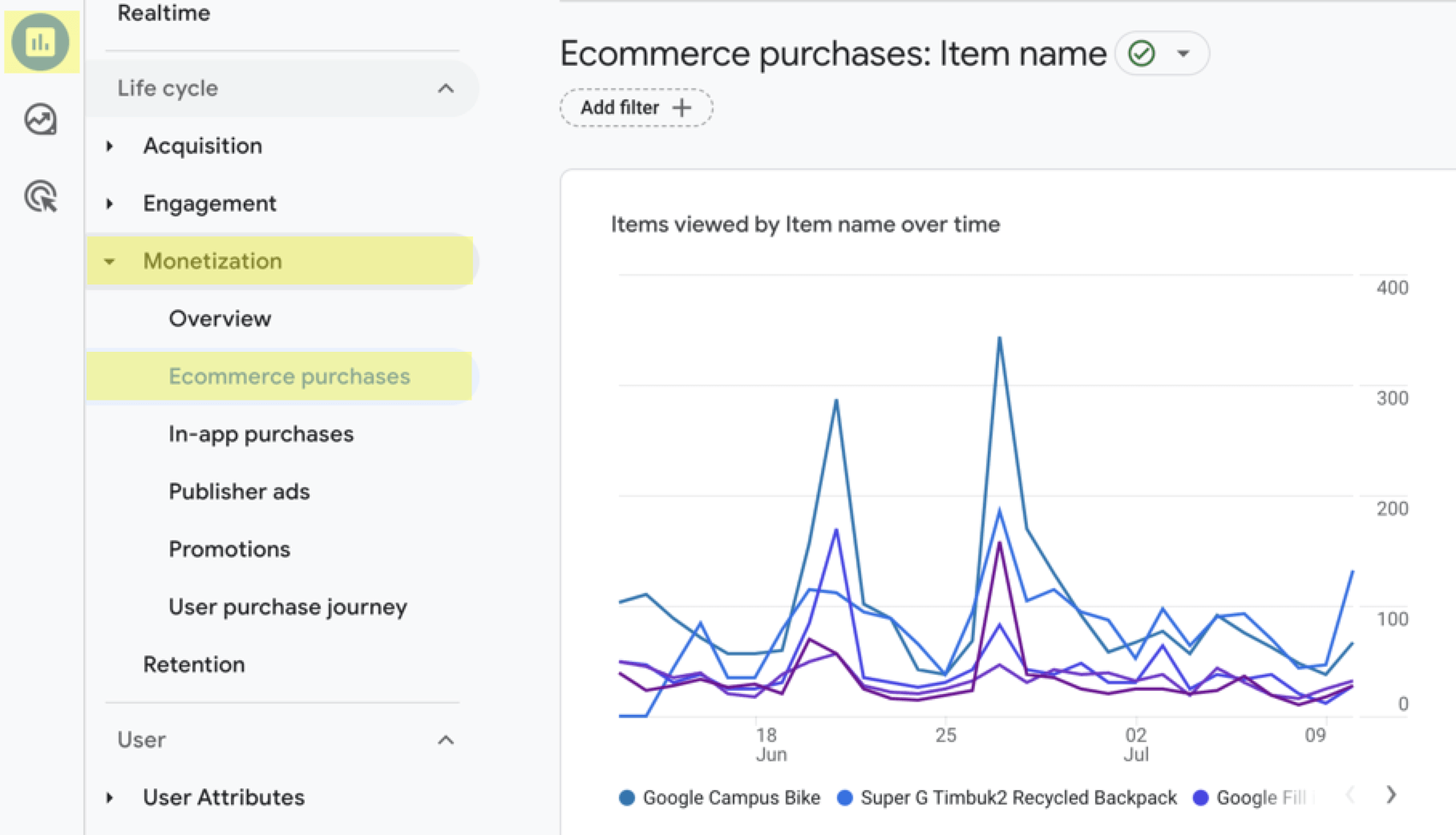
From there, add a filter for organic traffic.
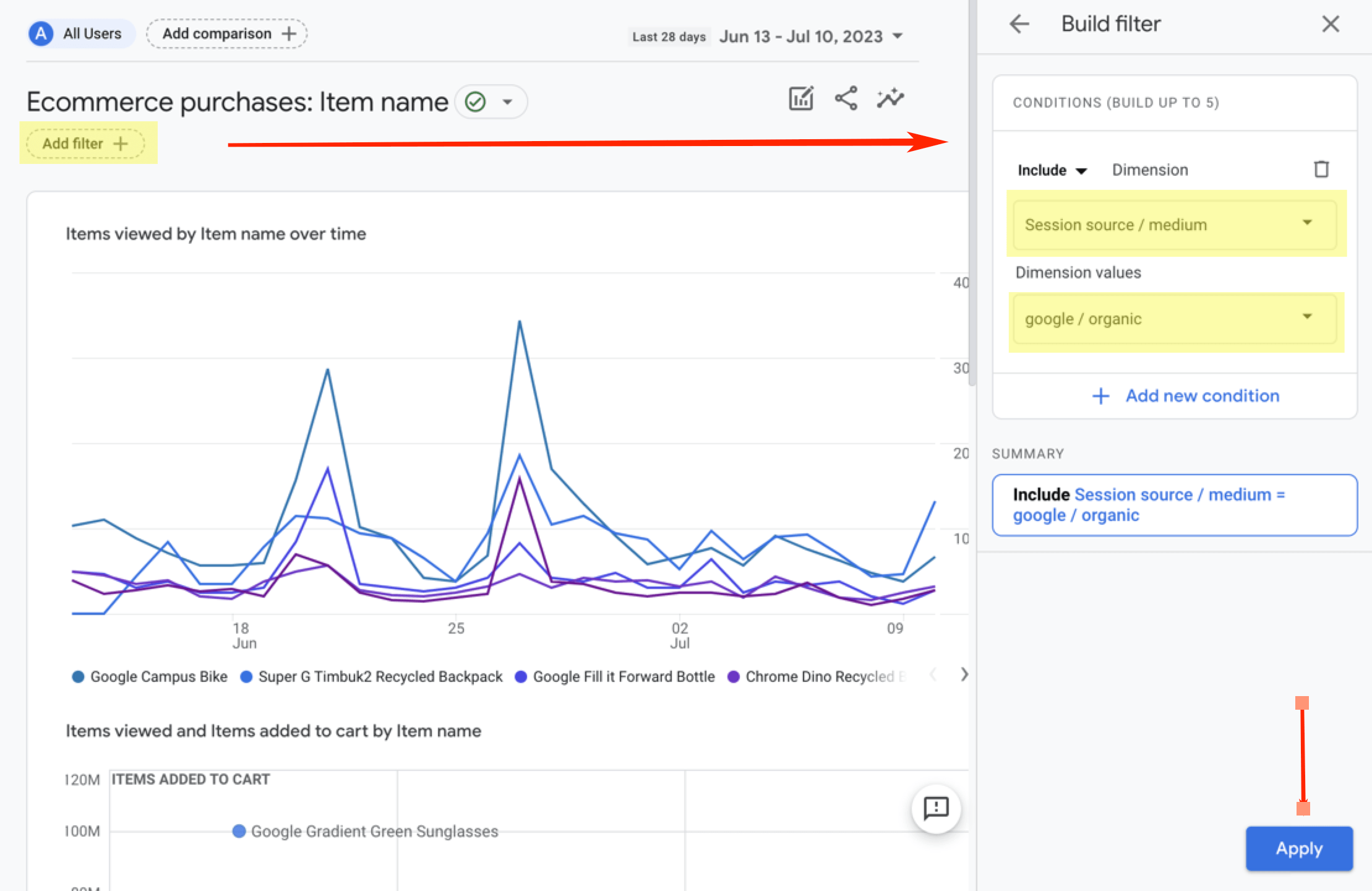
To get your total value of conversions, you must click on the insights button at the top right:
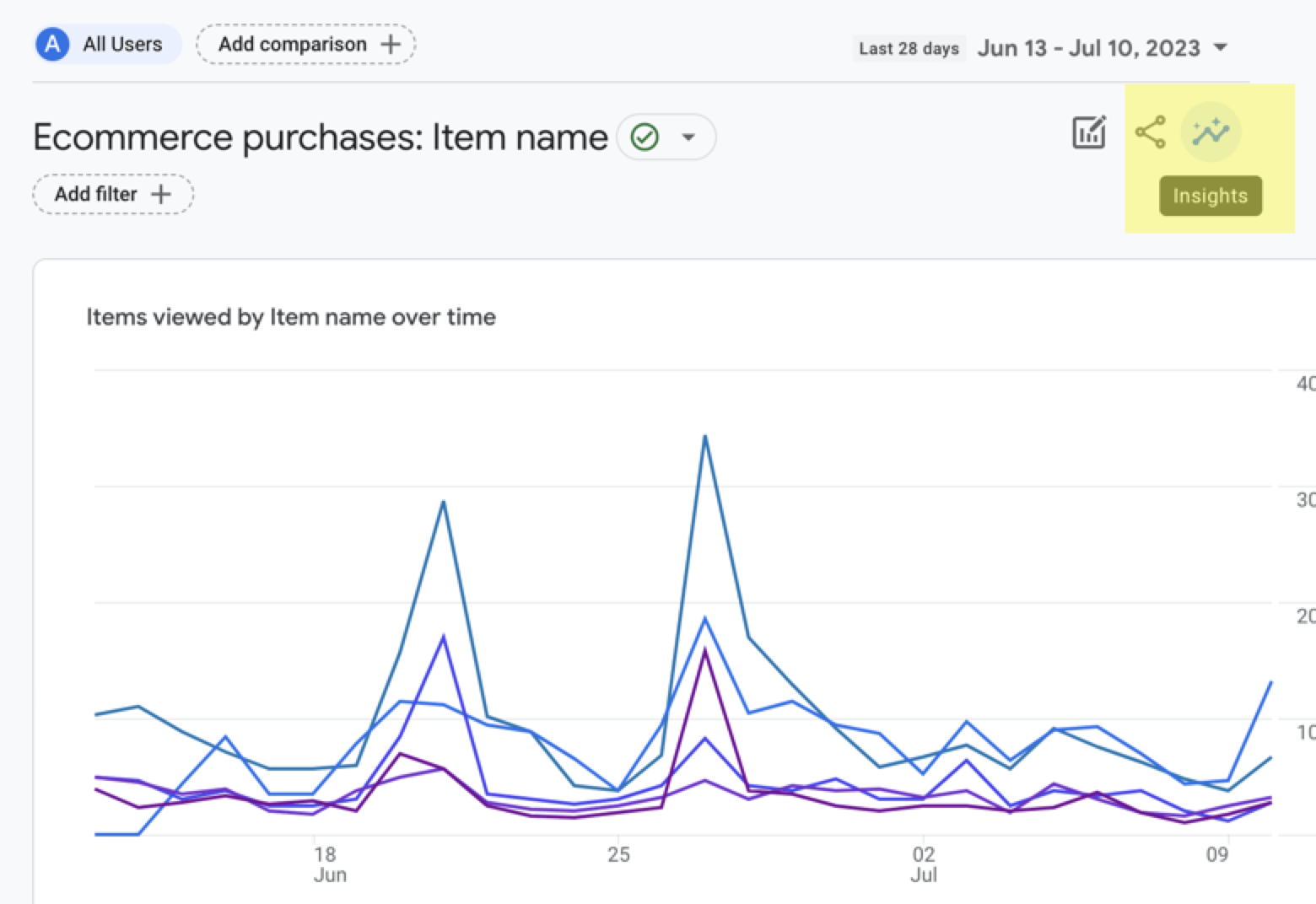
This report is useful for measuring your site’s overall success and monitoring your performance. So even if you aren’t planning to calculate your ROI from SEO immediately, we recommend setting up ecommerce tracking as soon as possible.
The sooner you start collecting data, the more you’ll have to work with when you decide to start digging into Analytics more.
Lead generation events
If you don’t make sales directly on your site, getting exact data on how much revenue you generate is a little more difficult. The most accurate estimate comes from assigning dollar values to each of your on-site conversions based on past sales data.
Navigate to Admin > Events to create goals for each of your on-site conversions:
![]()
Then, create an event for each of your conversions. These goals can range from contact form submissions, free quote requests, and even phone calls if you have call tracking set up on your site:
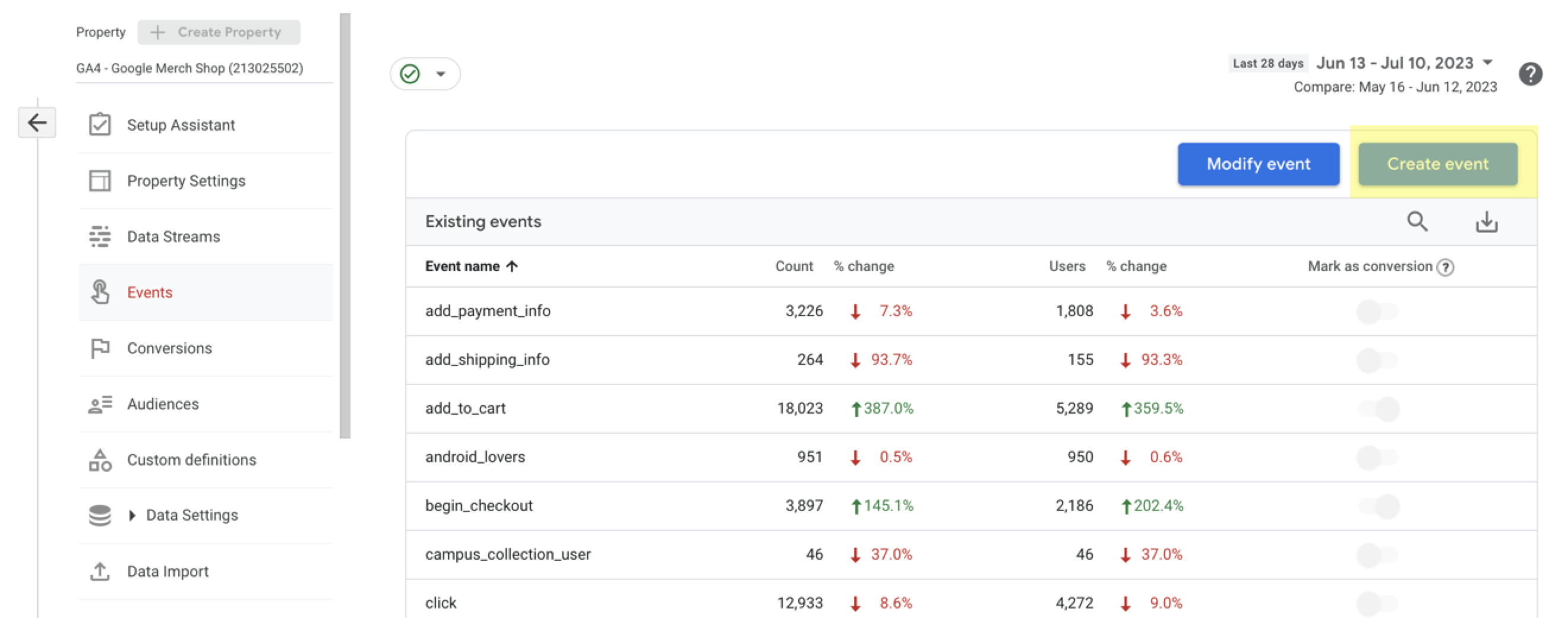
First, name your event, and add a “Parameter,” “Operator,” and “Value.” Then, once you add the event, you can mark it as a conversion:

Then, enter an estimated value for each of these conversions in the “Parameter configuration” section. These values won’t be exact, but if you have some analytics data to pull from, you can get a pretty accurate estimate.
Here’s how to find out what your listed value should be for each event:
- Determine how many of the leads convert into sales. For example, if you get 100 lead forms per month and 25 of those leads become customers, that goal has a 25% conversion rate.
- Determine the average value of each sale. If each of the leads that convert spends $200, your average value is $200.
- Determine the value of each lead. Determine the value of each lead by dividing the total value of conversions by your original number of leads. Using the values above, if you earn 25 customers and they each spend $200, you make $5,000. Divide that $5,000 by your original 100 leads, and each lead from this goal is worth $50 on average.
Follow this formula for each goal and enter the corresponding values before moving on to the next step.
3. Calculate your SEO ROI
One you’ve determined how much revenue your SEO strategy generated during a specific time (typically a month or a quarter), you can compare that amount to your SEO investment to determine your ROI.
Most businesses use the following formula to calculate SEO’s ROI:
(Gain from Investment – Cost of Investment) / Cost of Investment
If your company already has a method for measuring the ROI of your other marketing channels, you can use the same formula to compare SEO against them.
For example, some companies calculate ROI using the net profit from each sale instead of the total revenue. Use those same values for your SEO strategy, or your comparison will be skewed.
If you don’t have an existing method for calculating your marketing ROI, you can use the basic Investopedia formula (Gain from Investment – Cost of Investment) / Cost of Investment. Then, multiply the resulting number by 100 to get your ROI in percentage.
Using the data below, here is the SEO ROI formula in action:

The company’s return on investment from SEO is more than 600% — that’s massive!
User purchase journey: An alternative to measuring ROI SEO
If you want another way to track your ROI, the user purchase journey report (Reports > Monetization > User purchase journey) considers all the steps that lead to conversion.
But instead of showing each channel’s separate contributions, it shows the common paths your users take to converting:
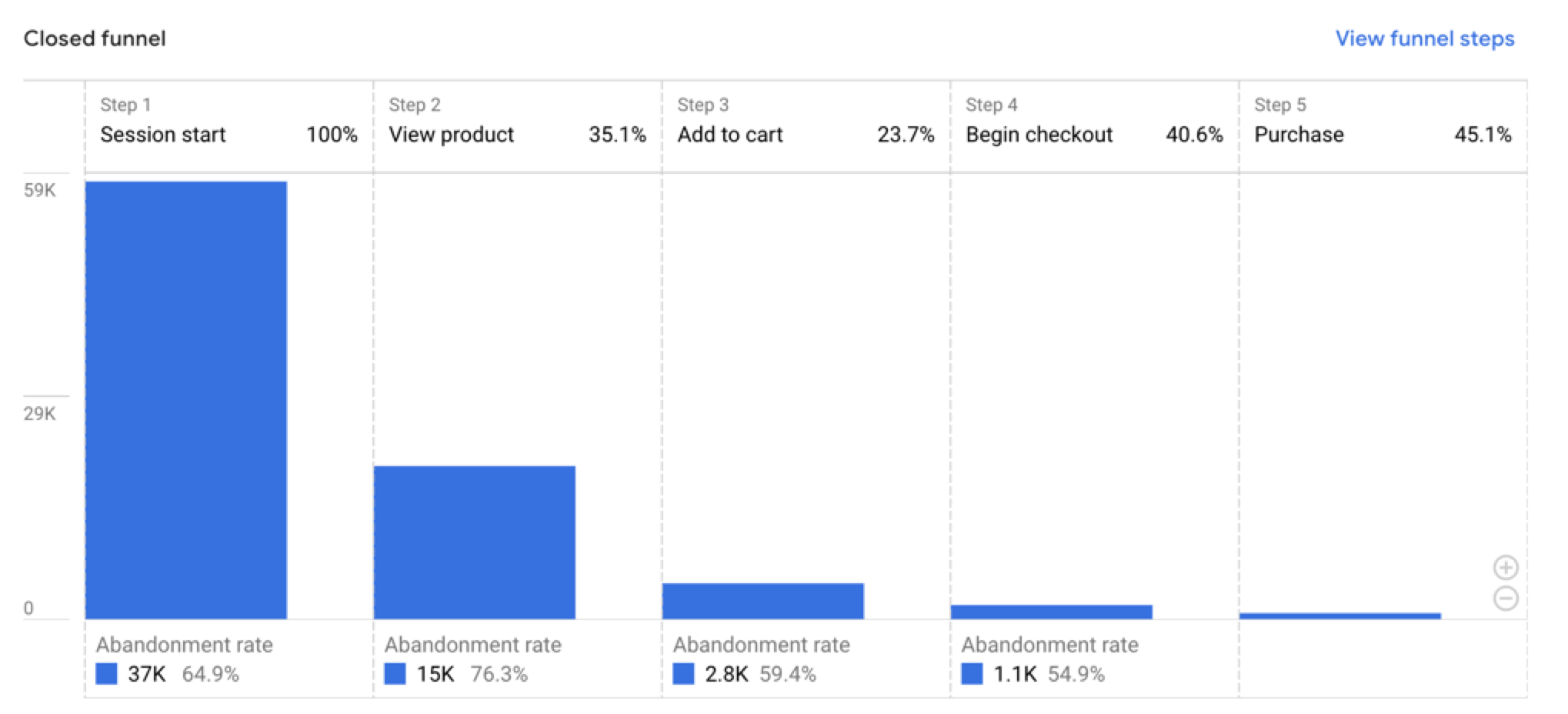
This report is helpful because it gives you a better idea of how your customers interact with your site and other channels before purchasing or becoming a lead. The more you understand your customers, the more effectively you can structure your campaigns moving forward.
Challenges to SEO ROI
While calculating SEO ROI is necessary to understand your business investments, it is not without challenges. Here are a few common issues companies run into when they try to calculate the ROI:
- SEO takes time to work: SEO is an ongoing process, and you often won’t see any results from your changes until four to six months after you implement them. The rolling timeline can affect the overall ROI.
- Gaps exist between investment and return periods: Looking at overall returns can be challenging since SEO is not time specific. Instead of looking at monthly or quarterly returns, checking for individual pages and keywords can be better.
- Retention impact is hard to measure: SEO can increase customer lifetime value, helping you build long-lasting relationships and lower churn rates. This benefit is nearly impossible to track when calculating SEO ROI.
With all that said, understanding your SEO ROI can help you make the right choices with your marketing budget. As you learn how SEO impacts your profit and generates leads in unqualifiable ways, you can better prioritize the aspects that are most likely to earn revenue.
SEO ROI examples by industry
Understanding how SEO ROI looks for your specific business is another key part of tracking ROI. Here are a few industry-specific examples of SEO ROI that show the impact of calculating ROI:
SEO ROI for ecommerce
Ecommerce companies, regardless of their market, are in a competitive market that relies heavily on visibility. Using SEO to place your product in front of prospects can have returns on your investment.
ROI for ecommerce SEO can be measured from sales brought in from organic traffic. For example, if your ecommerce company spends $5,000 per month on SEO, and you earn 150 organic sales at around $50 each, you’ll have $7,500 from organic sales, which is a 150% ROI.
Learn More: ROI for Ecommerce SEO
SEO ROI for healthcare
Healthcare organizations approach SEO ROI a bit differently. The “return” might be new patient appointments, elective procedure bookings, or increased inquiries for medical services.
A dental clinic investing in SEO might track how many appointment requests or calls come from organic search. If they invest $2,000 a month on SEO and gain five extra patient consultations worth $800 each, that’s $4,000 back – a 200% monthly ROI.
Healthcare also has a high customer lifetime value, meaning one new patient could lead to years of recurring visits or procedures.
SEO ROI for manufacturing companies
Industrial and manufacturing companies often have longer sales cycles and large contract values, which means SEO ROI might not be immediate — but when it hits, it’s big. A single organic lead can result in a six-figure contract.
We can illustrate SEO ROI industrial companies through lead value. If a manufacturing firm spends $5,000 on SEO in a quarter and secures one new client worth $50,000 in profit, that’s a 900% ROI for that quarter.
Industrial companies may only get a handful of organic inquiries per month — but converting only one can justify the SEO investment for a year.
5 SEO strategies for driving the best ROI
What if you could get a better return from search engine optimization (SEO)?
Chances are, you probably can, by focusing your SEO plan on SEO strategies that offer high returns. Some you may already use, while others may offer your business a new, untapped way to increase your return on investment (ROI) from SEO.
Keep reading to learn about the five SEO strategies that offer the best ROI, and how you can use them to generate better returns and more revenue for your business.
1. Maintain a fast, mobile-friendly website
A fast and mobile-friendly (or responsive) website is essential.
When it comes to determining where your site ranks in search results, Google looks at page speed and mobile-friendliness. If you have a slow site or a site that doesn’t display correctly on mobile devices, you can count on lower rankings.
When you think about SEO and ROI, rankings are critical.
If you don’t rank well in search results, you can’t attract the traffic necessary to generate an ROI from SEO. For perspective, around 95% of search traffic goes to the first page of search results, which means a page-one ranking is critical.
Maintaining a fast and mobile-friendly site can help your business rank on page one.
If you want to see how a fast and mobile-friendly website will benefit your bottom line — and SEO ROI — use Google’s “Test My Site” tool. This tool measures your mobile site’s speed and calculates how much revenue your business could get with a faster website.
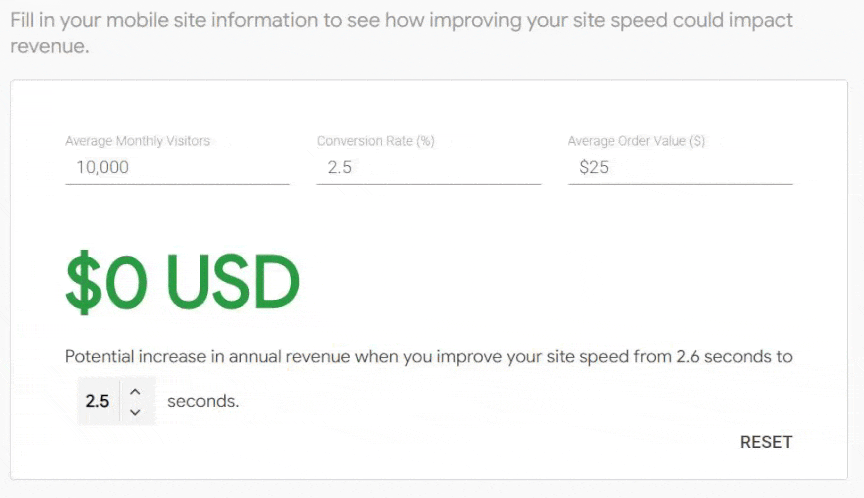 Speeding up your website usually involves the following:
Speeding up your website usually involves the following:
- Compressing site images
- Using external video hosting sites like YouTube
- Minifying HTML, CSS, and JavaScript
- Enabling browser caching
- Reducing server response times
While you can probably take care of compressing images and creating a YouTube account, other fixes like improving server response times and minifying code will require the help of a developer.
If a developer isn’t available to help, our U.S.-based team of developers can help. They can take a look at your site, find page speed opportunities, and implement fixes so you have a faster website that can rank higher in search results.
Like page speed optimization, mobile-friendly or responsive web design will require the help of a design and development team. While you can use website builders like WordPress, Wix, or Squarespace, it’s vital to check their SEO-friendliness beforehand.
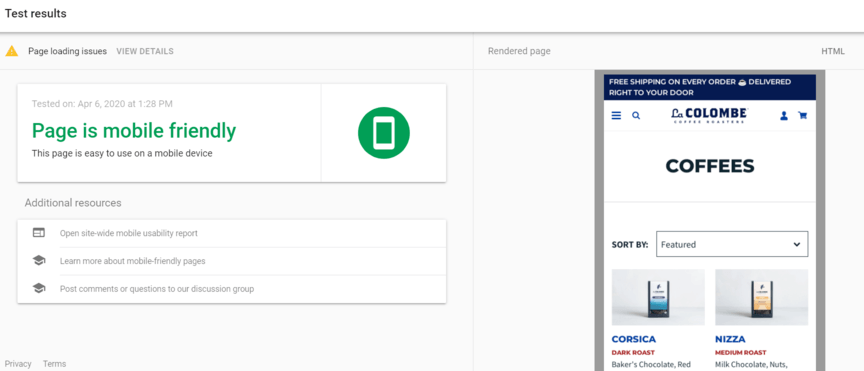 Alternatively, you can invest in professional web design that includes SEO optimizations.
Alternatively, you can invest in professional web design that includes SEO optimizations.
2. Target long-tail keywords
Keywords are a core component of SEO (and improving your SEO).
Finding relevant keywords, determining the search intent of those keywords, and mixing those keywords into your content and meta tags, will not only help people find your website but also help your content rank in search results.
You can choose from two types of keywords:
- Long-tail keywords: A long-tail keyword is three to four words, like “arabica coffee beans 12oz.”
- Short-tail keywords: A short-tail keyword is one to two words, like “coffee beans.”
Get the best ROI from SEO by researching and targeting long-tail keywords.
Long-tail keywords help your SEO strategy because they have less competition. Fewer people search for “arabica coffee beans 12oz” because it’s specific and caters to a specific search intent. In comparison, lots of people search for “coffee beans” because it’s general and captures a broad search intent.
 Not to mention, long-tail keywords target more specific search intents. Someone searching for coffee beans may want to know:
Not to mention, long-tail keywords target more specific search intents. Someone searching for coffee beans may want to know:
- How to choose coffee beans
- Which brands produce the best coffee beans
- How to use coffee beans
- What types of coffee beans to purchase
In comparison, someone searching “arabica coffee beans 12oz” is likely looking for someone that sells arabica coffee beans in a 12-ounce package. They know exactly what they want.
That’s why your business wants to target and rank well for long-tail keywords.
These keywords help your company reach people looking for products or services like yours. Instead of trying to bring as much traffic as possible to your website, you’re bringing the most qualified traffic, which means more leads, sales, and revenue for you.
KeywordsFX is an excellent tool for finding long-tail keywords — and it’s free.
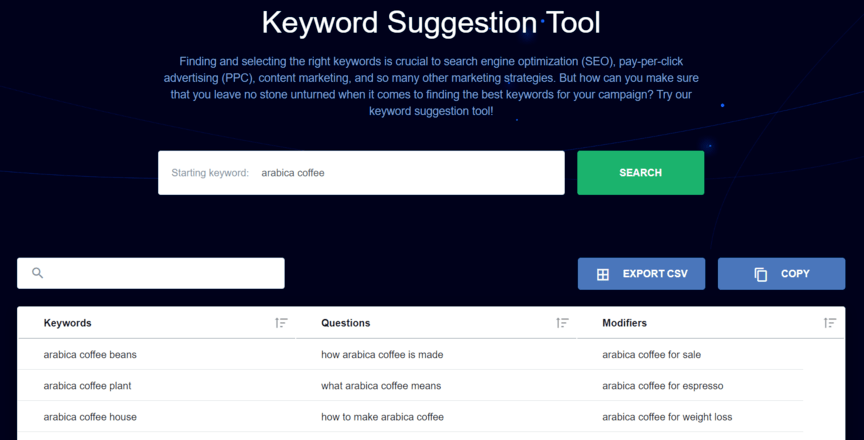 Just enter a starter keyword, like arabica coffee, and KeywordsFX will produce a list of related keywords, including questions that feature your keyword. You can also copy your results to save them for later or export them to view in Microsoft Excel or Google Sheets.
Just enter a starter keyword, like arabica coffee, and KeywordsFX will produce a list of related keywords, including questions that feature your keyword. You can also copy your results to save them for later or export them to view in Microsoft Excel or Google Sheets.
Finding and researching keywords is a process, and it’s only the beginning when it comes to SEO. If you feel intimidated or overwhelmed, don’t hesitate to ask for help from someone that specializes in SEO, like WebFX.
3. Optimize local listings
While local SEO matters more to some companies than others, local search still deserves a spot in your SEO roadmap— especially if you’re looking to increase your ROI from SEO.
That’s because local listings serve as a discovery and research hub for users. Searching for takeout in your area, for instance, will generate a list of potential businesses in Google search results. The same will happen when researching a company, whether it’s a restaurant or software provider.
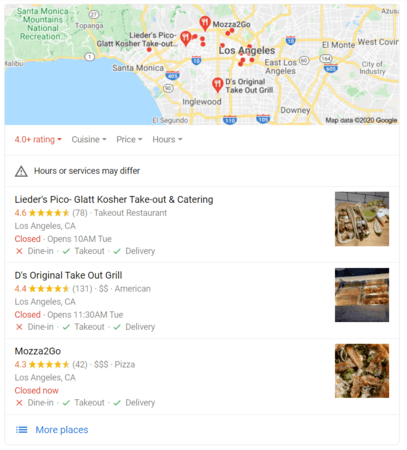 You want a presence in those search results because you’ll share with searchers your:
You want a presence in those search results because you’ll share with searchers your:
- Phone number
- Hours
- Website
- And more
This information makes it super easy for searchers — your future customers — to visit your site, learn about your offerings, and contact your team. Each of these actions helps a user move one step closer to conversion.
For the best return on this strategy, claim and optimize all your local listings. You can use a local listing management tool like LocalFX to streamline this process. It’ll take all your basic information, like name, address, phone number, and more, and auto-update your local listings for you.
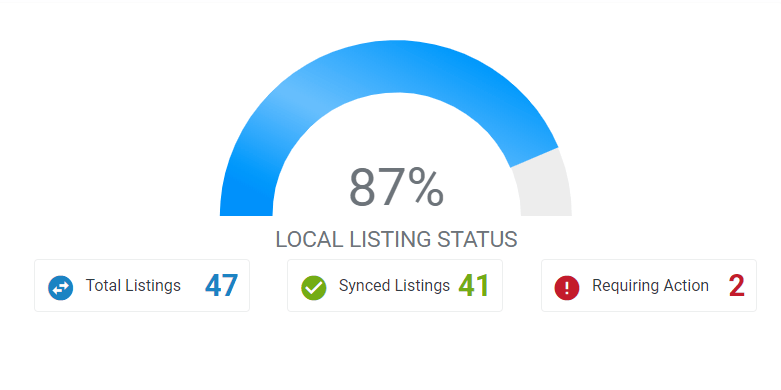 If you’re looking for local listing management help that goes beyond tools, we maintain an in-house, U.S.-based team of more than 500 SEO specialists. From managing your local listings to optimizing your local SEO, we will help you reach more people in your area.
If you’re looking for local listing management help that goes beyond tools, we maintain an in-house, U.S.-based team of more than 500 SEO specialists. From managing your local listings to optimizing your local SEO, we will help you reach more people in your area.
4. Create helpful content (and optimize it for SEO)
Content not only helps potential leads and shoppers get to know your business, but it also helps your company improve its SEO ranking, which is essential to attracting traffic and sales.
You can produce a variety of content, including:
- Blog posts
- Product pages
- Videos
- Guides
- And more
For the best ROI from SEO, it’s essential to create content for users and search engines. That means producing helpful, informative content that also follows SEO best practices.
For example, a blog post explaining how to ground coffee beans could include images or GIFs to help readers learn how to ground coffee beans while also featuring an optimized title tag, like, “How to Ground Coffee Beans: 3 Easy Options.”
When planning content, remember to focus on evergreen content topics.
Evergreen content doesn’t age as fast as other content. People will always have questions about how to grind coffee beans, for example, and the answer will generally stay the same. That kind of content will continue to generate website traffic and serve as a touchpoint in your audience’s path to purchase.
In comparison, a time-sensitive topic, like coffee bean shortages, will age out fast and attract little-to-no traffic. Your business doesn’t want to invest its time or money in this kind of content because it will diminish your ROI from SEO substantially.
Instead, focus on evergreen topics, and optimize them for users and search engines. If you need help developing and creating evergreen content for your website, WebFX features a dedicated team of SEOs, copywriters, and graphic designers that can work with you to produce long-lasting, A+ content for your site.
5. Re-optimize past content
Content refresh and re-optimization matters to your SEO ROI for three critical reasons:
- Content decays over time: Outdated content can lead to lower rankings in search results because searchers (and search engines) recognize that it’s old, whether due to its published date or information, which can make it irrelevant to a user’s search.
- Content carries long-term value: Updating evergreen content can maximize its value and impact on your bottom line. Content updates, for instance, can help a blog post or product page go from page two to page one.
- Search intent evolves: New technology, regulations, and standards can all shift search intent. Updating your content to account for these changes can help keep it fresh and relevant, as well as ranking high in search results.
For the best results with this strategy, follow these tips:
- Start with pages that rank on page one, two, or three
- Look at the search results to determine the search intent
- Conduct keyword research to find additional keywords to target
- Use the core keyword in the title tag and first 100 words
- Update any outdated practices, studies, or statistics
- Check every page’s mobile-friendliness and page speed
- Add helpful images, videos, or GIFs
Once you update a page, submit a crawl request in Google Search Console.
Google may take a few days or weeks to crawl the page, but when it does, it’ll see the updated information. Once this information enters its index, Google can move forward with tweaking its search results — and your position in them.
Re-optimizing content can seem like another to-do on an already long to-do list. It’s understandable, too. If that’s how you feel and you’re looking for help, WebFX can provide support through our award-winning SEO team.
FAQs about measuring ROI for SEO
Do you have additional questions about measuring ROI for SEO? Browse our FAQ!
When should I measure SEO’s ROI?
Generally, you’ll measure SEO’s ROI monthly, quarterly, and yearly. Since SEO is a long-term strategy and takes time to generate results, you probably won’t see a positive ROI in the first three to six months. After this initial period, SEO can start delivering a return — and continue providing one.
How do I measure SEO’s ROI?
Measure SEO’s ROI with the following formula:
- (Gain from Investment – Cost of Investment) / Cost of Investment
Calculate your expenses for investing in SEO to get your “Cost of Investment,” and then reference your Google Analytics data to get your “Gain from Investment.” Substitute your numbers in the formula, and you’ll get your ROI from SEO.
What is a good SEO ROI?
A good SEO ROI depends on your business.
Every company is different, which makes assigning an average or good SEO ROI difficult. While one business invests $1500 monthly in SEO, another spends $3000. Not to mention, lead values vary from company to company.
Before you start optimizing your site for SEO, think about brainstorming an ideal ROI for your business. This number can be a benchmark for your team or agency to measure against itself. For the best results, start with a small percentage and then work towards a larger one as you gain data.
How do I improve SEO ROI?
Here are a few tips to make sure your ROI reflects high returns from your SEO:
- Focus on keywords and high quality content
- Make sure your site loads quickly and on mobile
- Find an ROI tracking tool that works well for your business
- Optimize your landing pages
- Give SEO time to work
Get a stronger ROI from SEO with WebFX
A well-structured SEO strategy can produce impressive ROI for businesses in all industries – and if yours isn’t where you’d like it to be, WebFX can help.
We focus on ROI right from the start and create custom strategies for each of our clients to provide the best returns possible. For more information about our organic SEO services, contact us today and get a free quote!
Marketing Tips for Niche Industries
- How to Build Links for Your Ecommerce Business
- How to Build Links for Your Hotel Website
- How to Increase Higher Education Enrollment with SEO
- How to Master Search Engine Optimization for Garage Door Companies
- How to Optimize SEO for Dog Trainers
- How to Use SEO for Machinery Manufacturers
- How Tutors Can Use SEO to Successfully Get Clients
- HVAC SEO Services
- Inside SEO for Transportation and Logistics Companies
- Long Tail SEO Keywords for Medical Practices
Additional Reading
- How to Get Links and Traffic for Subsidiary Sites
- How Voice Search Shopping Will Affect Your Business: 4 Tips for Adapting to Voice Search
- How to Find & Hire SEO Experts Like a Pro
- How to Implement Hreflang on Your Website
- How to Increase Domain and Page Authority
- How to Measure on and off Site SEO
- How to Measure Your SEO Success
- How to Rank Better for “Almost-There” Keywords
- How to Write a Title Tag: 8 Best Practices
- Importance of Long Tail SEO
- Is SEO Backlinking Ethical?
- Is SEO Important for Every Business?
- Is SEO Still Relevant?
- Is SEO Worth It? a Study of the Value of SEO by WebFX
- Keywords Vs Search Queries

